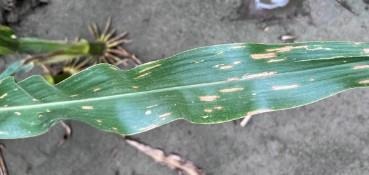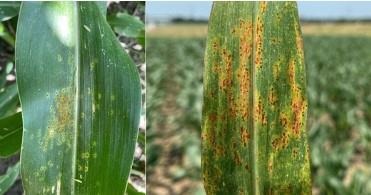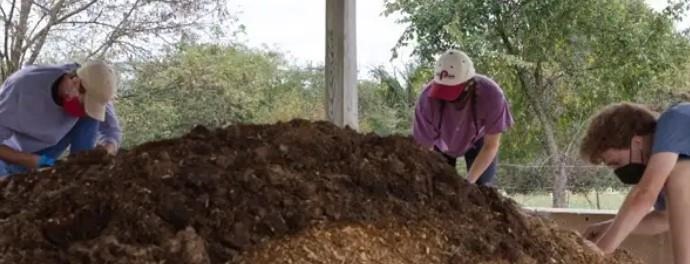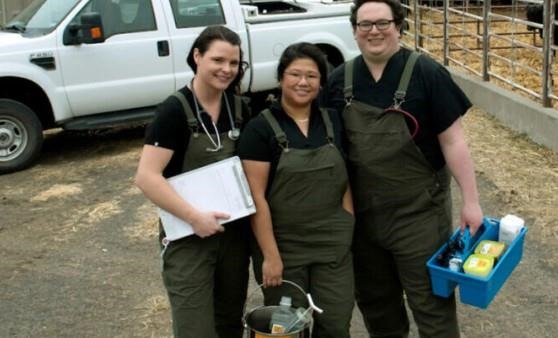In research published in the Journal of Integrated Pest Management, University of Delaware graduate student Ben Sammarco, UD faculty member Michael Crossley and the University of Georgia’s Nancy Hinkle dive deep into the biology and integrated pest management of lesser mealworm (Alphitobius diaperinus), a species of darkling beetle that wreaks havoc on poultry farms.
The poultry industry is both a historic and modern economic driver across the Delmarva peninsula. In 2022, the Delmarva chicken farmers produced 4.4 billion pounds of chicken and generated $5 billion in wholesale value. That’s the most productive year in Delmarva’s 100-year history in the industry, according to the Delmarva Chicken Association.
Threats like lesser mealworm require serious attention. At the onset of industrial chicken and turkey farming, the species announced itself wherever broiler houses were found. The beetles’ damaging handiwork strains a farmer’s bottom line. But, as the UD research team highlights, exactly how great of a cost is difficult to pinpoint.
“Part of the issue is we don’t know how much damage lesser mealworm costs farmers financially,” said Sammarco, who is pursuing his master of science in entomology. “A lot of their damage to poultry farms is indirect to costs and profits.”

The research team hopes to paint an industry-wide picture of the pests’ damage.
“Knowing how much damage an insect population can cause, and translating that into dollars, is an important step in deciding what management expenses are economically justified,” said Crossley, assistant professor and agricultural entomologist. “Spray too much, and we’ll likely see insecticide resistance problems. Spray too little, and we might start seeing structural damage and spread of bird and human pathogens.”
Indigenous to Africa, a lesser mealworm poses no threat in the wild. But poultry houses around the world proved too tempting for these darkling beetles. Living in bird nests, these pests proliferate worldwide, feeding off organic material like feathers and bird droppings. Poultry houses are their oasis, inflicting damage to a farm facilities’ support posts and insulation. And just like your own home — poor insulation likely means a bigger heating bill.

In addition to the financial cost, these unwanted guests are disease reservoirs, carrying salmonella, E. coli, Marek’s disease and turkey coronavirus. If a chicken eats a beetle, the insect’s hard exoskeleton makes them difficult to digest; for young chicks, eating too many beetles can stunt growth or even kill them.
Better industry-wide trapping and control practices are also high on poultry farmers’ wish list. As the research paper highlights, insecticide resistance is an ever-present obstacle. As with other pests, insecticides do not work indefinitely. Lesser mealworm populations become resistant to specific insecticides after ten years of consistent use. As the beetles develop resistance, farmers need new methods augment or replace their current insecticide regimes.
“The industry currently doesn’t have strong indicators or monitoring strategies,” Sammarco said.
So, is there a way to slow down the beetles? Temperature. Hot and cold conditions can’t eradicate but can inhibit the pests. When farmers are in-between chicken flocks, some practice windrowing — piling poultry litter into mounds. This sanitation practice heats up their environment, killing bacteria and pushing out the beetles. The farmers could then close the ventilation and beetles can’t take the heat. In the winter, the opposite temperature is the insects’ kryptonite; farmers can open ventilation, using the chilly air to eradicate these tropical pests.

Building on this research, UD’s Agricultural Entomology Lab is now investigating the beetles’ movement patterns. Sammarco is searching for what behavioral drivers lead to movement within houses. Researchers know where the insects go, but not why they go to different parts of the houses.
“For example, we are running experiments on different wavelengths of light and the presence or absence of water,” Sammarco said. “Do they move towards or away from certain light? Do you move towards or away from water at different stages?”
With that tracking knowledge, improved trapping and control practices would follow, much to the delight of farmers and their bottom line.
“For example, if we find the beetles are repelled by green light, we could illuminate the space of the poultry house where the chicks are kept,” said Sammarco.
Improved pest control could mean significant savings industry wide.

The researchers are also investigating the darkling beetles’ geographic movements. Collecting samples across the United States and Europe, the UD team is focused on the beetles’ gene sequence to see where one group is exchanging genetic material to another.
“We hear anecdotes about how a new house gets built and as soon as the first flock of birds is in, darkling beetles just show up. How did they get there?” Crossley said. “We have some hunches, but need data to test them. Genetic markers could be a useful tool in testing the role of long-distance movements among poultry farms.”
Despite its reputation as a pest, lesser mealworm remains a very interesting species. Sammarco likens the mealworm’s attraction to poultry houses to the wet environments near human-made structures that mosquitoes can’t resist.
“Lesser mealworm is a pest through no fault of their own,” Sammarco said. “They are a pest only because of the environment that we made.”
Source : udel.edu